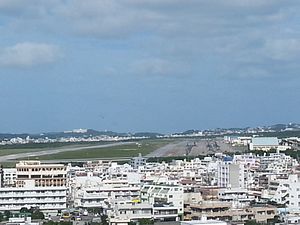On Saturday the Japanese Defense Ministry revealed that efforts to send Self-Defense Force members to a U.S. airbase on Okinawa for safety checks have been at a standstill since February. Government measures to verify safety standards at Marine Corps Air Station (MCAS) Futenma were intended to quell public backlash, but the operation has yet to materialize.
On February 1, Japan’s Self Defense Forces (SDF) were left hanging when U.S. forces requested that the safety investigation at MCAS Futenma be postponed on the day SDF members were scheduled to be dispatched. SDF personnel with technical expertise intended to assess the maintenance situation, in particular emergency landing functions, and attend briefings on two recent aircraft malfunctions.
Defense Minister Itsunori Onodera said a team of experts were to survey equipment and ascertain whether the explanation from the U.S. side matched up technically. Although the United States initially agreed to the plan, it was abruptly explained that they needed more time for preparations. The U.S. side has failed to respond to concrete talks since the mission was put on hold.
Japan’s southern island of Okinawa is known as a tropical holiday destination, but it’s also home to the main bulk of U.S. military bases in Japan. Since World War II, Okinawans have carried a sentiment of distrust toward the U.S. military bases. But the rape and murder of a Japanese school girl in 1995 by three American servicemen became a major political turning point, fueling hostility and local protests against the presence of military personnel in Okinawa.
Recently, the question of public safety has put U.S. forces in the spotlight in Japan after a string of recent helicopter accidents triggered public outrage. In December, a window from a heavy duty transport aircraft fell and landed in the playground of an elementary school near MCAS Futenma. The U.S. military voluntarily pledged to avoid flights over the school; reports that countless aircraft have been flying overhead anyway have been denied by the United States. A Japanese Defense Ministry survey found students were forced to evacuate the playground 216 times within the space of a month due to approaching U.S. aircraft.
The U.S. military got off to a rocky start this year with two Futenma-based UH-1 multipurpose helicopters making emergency landings on January 8 and January 23. More recently, in April tensions skyrocketed after two more incidents of emergency landings were reported while a U.S. Air Force parachute was also found on a school grounds in Tokyo.
However, February and March stood out for three potentially deadly accidents. A 1.4 kg antenna-like part fell off during the flight of a fighter jet based in Kadena Air Base in Okinawa with a while another fighter jet based in Misawa, southeastern Japan, was forced to dump fuel in a nearby lake after an engine fire. In early March, a plastic rear door from a cargo helicopter weighing 31 kilograms was found in a grass field in a remote island in southwest Japan.
The frequency of U.S. aircraft accidents last year doubled compared to 2016, and the trend for emergency landings this year looks discouraging. But U.S forces have praised precautionary landing as a way to prevent possible crashes. Local residents, however, say they’re under continuous threat from falling military debris and have made pleas to the government based on the constitutional right to live in peace.
The Japanese government has sought to take a heavier hand in addressing the ballooning number of aircraft accidents. However, residents remain convinced public safety has taken a back seat to their U.S. allies. Prime Minister Shinzo Abe reassured residents that working on safety with the United States is a top priority, emphasizing that the basic premise of U.S. military operations is to ensure public safety. He urged the United States to take appropriate measures to prevent accidents from occurring again.
The United States has criticized the safety probe as a groundless inspection and with limited cooperation, a senior Defense Ministry official said, it’s unclear when the safety probe can resume.
































